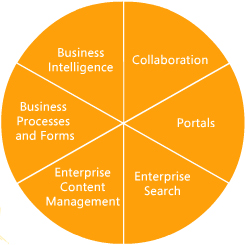Roadmap to using SharePoint Server 2007
Are you new to Microsoft Office SharePoint Server 2007? Or do you use a SharePoint site to store documents, but now you're curious about workspaces, blogs, and wikis? Or do you want to dig deeper and share business data more efficiently by using reports, dashboards, and key performance indicators (KPIs)?
Use this roadmap as a starting point to learn about the broad capabilities of Office SharePoint Server 2007 and how to complete common tasks as a contributor to a SharePoint site. You can also find links to site owner tasks, such as setting up permissions and doing some basic customization.

The capabilities of Office SharePoint Server 2007 are focused in six areas. This roadmap briefly introduces each of these capabilities and then links to related articles where you can learn more.
Note: For information about installing SharePoint Server, see the Office SharePoint Server TechCenter. For information about building SharePoint Web applications, see the SharePoint Server 2007 Developer Portal.
In this article
Collaboration
You can use a SharePoint site to share information and do your work more efficiently. A SharePoint site offers workspaces and tools that your team can use to track projects, coordinate schedules, and collaboratively create and edit documents. For more information about how you can use a team site, click the following links.
Improve team productivity by using a SharePoint site
You can use a site to store routine information for a single department or short-term information for a special project that spans several departments. By using a collaborative workspace such as a team site, your team can become more efficient and more productive.
Manage projects more efficiently
You can use a site to manage projects and coordinate tasks and deadlines among team members. The Project Tasks list template includes a Gantt chart view where you can see task relationships and project status. Your team can coordinate their work with shared calendars, alerts, and notifications. You can also connect a calendar on a SharePoint site to your calendar in Microsoft Office Outlook 2007, where you can view and update it as you do your personal calendar.
Create, review, and publish documents
Groups of people can create, review, and edit documents collaboratively on a SharePoint site. You can use document libraries to store and manage important documents, or use Document Workspace sites to coordinate the development of specific documents. Slide Libraries are a great location to share and reuse Microsoft Office PowerPoint 2007 slides in a central location. You can take document libraries offline in Office Outlook 2007 to enable people to view and edit documents while they are not connected to the network.
Capture and share community knowledge
You can use a team site to capture and share collective team knowledge or important information. Teams can create and capture community knowledge or document internal processes in a wiki. You can use surveys or discussions to gather information or encourage dialog, and then share your findings in a blog. Team members can use alerts or Really Simple Syndication (RSS) to track updates to your sites.
Portals and personalization
You can use portal sites to work collaboratively and access the people, information, and business applications that you need to do your job. Office SharePoint Server 2007 includes features that organizations can use to personalize the portal site for individuals or groups of users. For more information about portals and personalization on SharePoint sites, click the following links.
Search
You can use search on a SharePoint site to help you find information, files, Web sites, and people. For more information about how to use search, click the following links.
Enterprise Content Management
Office SharePoint Server 2007 provides powerful Enterprise Content Management (ECM) features for creating, managing, and storing content throughout an enterprise. You can use workflows to help manage the process of creating, reviewing, publishing, and even managing the content that your organization creates.
Document management
Document management capabilities can help you consolidate content from multiple locations into a Document Center, which is a centrally managed repository that has consistent categorization.
Records management
Integrated records management capabilities can help you store and protect business records in their final state.
Web content management
Web content management capabilities enable people to publish Web content with an easy-to-use content authoring tool and a built-in approval process.
Business process and forms
Office SharePoint Server 2007 provides many features that can help you integrate and streamline your business processes. You can create browser-based forms and gather data from organizations that do not use Microsoft Office InfoPath 2007. Workflows can streamline the cost of coordinating common business processes, such as project approval or document review, by managing and tracking the tasks involved with those processes. For more information about business process and forms, click the following links.
Business intelligence
Business intelligence is the process of aggregating, storing, analyzing, and reporting on business data to support informed business decisions. Office SharePoint Server 2007 provides tools that can help you extract data from a variety of sources and present that data in ways that facilitate analysis and decision making. For more information about business intelligence in SharePoint Server, click the following links.
No comments:
Post a Comment